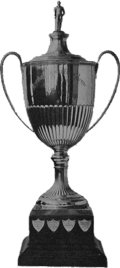 The trophy awarded to champions | |
| Organiser(s) | |
|---|---|
| Founded | 1900 |
| Abolished | 1919 |
| Region | Buenos Aires city Greater Buenos Aires |
| Related competitions | Copa Competencia (Arg) Copa Competencia (Uru) |
| Last champions | |
| Most championships | (6 titles) |
The Tie Cup Competition (also known as Copa de Competencia Chevallier Boutell) was an international football tournament played between representatives of the Argentina and Uruguay Associations. It was one of the earliest international football tournaments played between members of different national football associations, played on an annual basis until 1919. [1]



